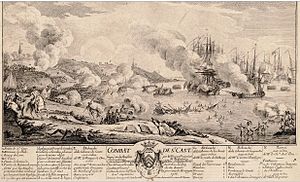Lord Frederick Cavendish (British Army officer)
Lord Frederick Cavendish | |
|---|---|
| Born | August 1729 |
| Died | 21 October 1803 (aged 74) Twickenham Park, Middlesex |
| Buried | |
| Allegiance | |
| Service/ | |
| Years of service | 1749–1803 |
| Rank | Field Marshal |
| Commands held | Brigade of chasseurs |
| Battles/wars | Seven Years' War |
battle of Saint Cast and was taken prisoner. After his release, Prince Ferdinand of Brunswick gave him command of a brigade of chasseurs which he led to victory at the Battle of Wilhelmsthal
in June 1762.
Military career

Born the son of
Member of Parliament for Derbyshire in 1751.[2] He was promoted to lieutenant in the 2nd Regiment of Foot Guards and captain in the Army on 17 March 1752.[3]
In 1754, Cavendish gave up the Derbyshire seat for his brother
lieutenant-colonel and went to Ireland with his brother William Cavendish, Marquess of Hartington, newly made Lord Lieutenant of Ireland, in 1755.[1]
Cavendish was promoted to captain in the 1st Regiment of Foot Guards and lieutenant-colonel in the Army on 1 June 1756Duke of Aiguillon in an exchange for a French officer of equal rank in October 1758.[6]
Cavendish became colonel of the
major-general on 7 March 1761, he sailed for Germany where Prince Ferdinand of Brunswick gave him command of a brigade of chasseurs which he led to victory at the Battle of Wilhelmsthal in June 1762.[7] Part of his brigade was ambushed during the Siege of Kassel in October 1762.[1]

Cavendish was promoted to
He died at his home,
Lord George Cavendish, later 1st Earl of Burlington.[1]
Family
Cavendish never married and he had no children.[6]
References
- ^ a b c d e f "Lord Frederick Cavendish". Oxford Dictionary of National Biography. Retrieved 22 June 2014.
- ^ a b c Heathcote, p. 82
- ^ Mackinnon, Daniel (1833). Origin and Services of the Coldstream Guards. Vol. II. London: Richard Bentley. pp. 486–487.
- ^ "No. 9590". The London Gazette. 8 June 1756. p. 2.
- ^ "No. 9789". The London Gazette. 6 May 1758. p. 2.
- ^ a b c d Heathcote, p. 83
- ^ "No. 10227". The London Gazette. 17 July 1762. p. 1.
- ^ "No. 12391". The London Gazette. 23 September 1782. p. 1.
- ^ "No. 13918". The London Gazette. 2 August 1796. p. 743.
Sources
- Heathcote, Tony (1999). The British Field Marshals, 1736–1997: A Biographical Dictionary. Barnsley: Leo Cooper. ISBN 0-85052-696-5.
External links
- . Dictionary of National Biography. London: Smith, Elder & Co. 1885–1900.
